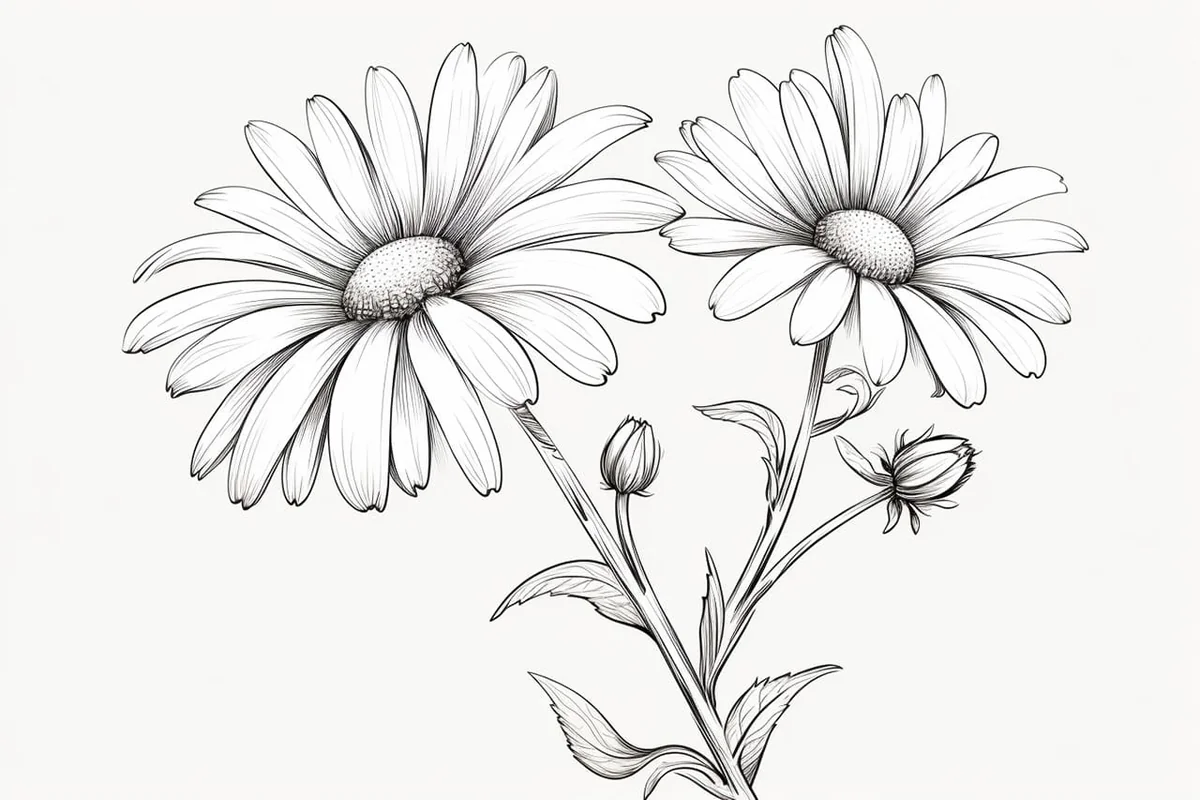How to Draw a Daisy in 8 Easy Steps
Learn how to draw with this step-by-step tutorial.

Materials You'll Need
- Drawing paper
- Pencil (HB or 2B)
- Eraser
- Colored pencils
- Markers
- Blending stump
- Watercolor paints

Welcome to this step-by-step guide on how to draw a daisy, the flower that's as cheerful as it is timeless! With its bright petals and sunny center, the daisy symbolizes purity, innocence, and a touch of whimsy that makes it a favorite in gardens and art alike. In this guide, we'll break the process down into easy-to-follow steps, so whether you're a seasoned artist or just starting your creative journey, you'll find yourself crafting a charming daisy with confidence.
Along the way, you'll also learn tips for adding depth, texture, and personality to your drawing, turning a simple flower into a piece that radiates life and beauty. So, gather your art supplies, get comfortable, and let's bring a little sunshine to your sketchbook!
Materials Required
To draw a daisy, you'll need the following materials:
-
Pencil
-
Drawing paper or sketchbook
-
Eraser
-
Fine-tip marker or pen
-
Colored pencils or markers (optional for coloring)
Now that we have everything we need, let's begin our artistic journey!
How to Draw a Daisy Step-by-Step
Step 1: Plant the Seed—Sketch the Daisy's Center
Begin by drawing a small circle smack dab in the center of your paper. This will be the floret—the heart of your daisy and the focal point of your masterpiece. Don't stress about perfect symmetry; nature's charm lies in its imperfections. Keep it light and loose, as you'll refine it later. Think of this as planting the seed for your daisy to bloom.
Step 2: Start Petaling
Now, it's time to give your daisy its signature flair! Around the floret, lightly sketch elongated ovals for the petals. Daisies typically flaunt 12 to 30 petals, so pick a number that feels right to you. Space them evenly, but don't overthink it—leaving a few small gaps adds a touch of natural beauty. Imagine these petals radiating outward like sunshine beams.
Step 3: Shape Up Those Petals
Here's where your petals get their personality! Go back and refine each oval, giving them a slightly pointed tip and softly curving edges. Daisies have slender petals that taper delicately at the tip. Embrace variety—no two petals need to look exactly alike. A little imperfection can make your daisy look even more lifelike, as though it was just plucked from the garden.
Step 4: Perfect the Floret
Now, revisit the floret in the center. Erase any wobbly lines to make the circle more even, but don't overdo it—this is a flower, not a geometry project. Add some feathery, short lines or tiny dots inside the floret to hint at the stamens' texture. This will give your daisy some botanical pizzazz and depth.
Step 5: Trace Your Masterpiece
Grab a fine-tip pen or marker and carefully trace over your pencil lines. Start with the petals, making smooth, steady strokes that follow their graceful curves. Move on to the floret, tracing the outer edge and any texture details you've added inside. This outlining step transforms your sketch into a polished work of art. Take your time—this is where your daisy really starts to bloom!
Step 6: Add the Floret's Finishing Touches
With the same pen or marker, add more fine lines or tiny dots radiating outward from the floret's center. These lines represent the stamens and create that iconic daisy texture. Keep it subtle; you're aiming for elegant detail, not a fireworks show. Balance is key—less is often more in the delicate world of florals.
Step 7: Clean Up the Canvas
Once the ink has dried (give it a few minutes, just to be safe), gently erase all the pencil lines. This step is like sweeping away the scaffolding after building a cathedral—it reveals your clean, polished daisy in all its glory. Be careful not to smudge the ink while you work, and marvel at how crisp your drawing looks now!
Step 8: Bring in the Sunshine (Optional)
Feeling colorful? Now's the time to add a splash of life to your daisy! Daisies typically have white petals and a cheerful yellow center, but don't let tradition stop you. Use colored pencils or markers to fill in the floret with vibrant yellows, blending in a few darker shades for depth. For the petals, use light gray or blue tones to suggest shadows, making the white pop. You can even go bold with a pink or purple daisy—your art, your rules!
Bonus Tip: Frame Your Bloom
If you're feeling extra creative, consider adding a simple background—a soft green for grass, a pale blue for sky, or even a hint of sunlight. A daisy this delightful deserves to shine in a setting as lovely as it is!
Blooming Success: Your Artistic Garden Awaits
Congratulations, artist! You've just brought a daisy to life on paper, and it's a beauty. Each petal, curve, and detail showcases your growing skill and creativity. With practice, your daisies will become even more realistic, their charm blooming with every stroke. Remember, no two daisies in nature are identical, and your artistic creations should be just as unique—so don't be afraid to experiment with different styles, colors, or even fantastical designs.
Drawing flowers like daisies not only deepens our appreciation for the delicate beauty of nature but also opens a doorway to endless artistic possibilities. This simple flower is a canvas for your creativity, so enjoy the process, embrace happy accidents, and let each daisy reflect your personal touch. Keep exploring the world of art, adding new blooms to your garden of sketches. The next masterpiece is just a pencil stroke away! ✨
Gallery of Daisy Drawings



Fun Facts About Daisies
-
Daisies belong to one of the largest plant families in the world, the Asteraceae family, which includes other floral stars like sunflowers and dandelions. With over 32,000 species, it's one of the most botanically diverse families on Earth.
-
What looks like a single daisy flower is actually a tiny bouquet in disguise. Each "petal" is a ray floret, and the center is filled with disc florets—together forming a classic composite flower structure.
-
Daisies symbolize innocence, purity, and new beginnings, making them a timeless choice for springtime art, bouquets, and celebrations. Their symbolism dates back centuries and continues to resonate today.
-
The name "daisy" comes from the Old English day's eye because the flower opens at dawn and closes at dusk—nature's own alarm clock.
-
Daisies grow almost everywhere, thriving in wild meadows, tidy gardens, and even the cracks in city sidewalks. Their global distribution spans every continent except Antarctica.
-
Daisies are surprisingly resilient, often growing in poor soil and bouncing back after being trampled. Shasta daisies, in particular, are known for their toughness and adaptability.
-
Daisies have edible petals and leaves, which can be added to salads or brewed into herbal teas—though their flavor is mild and slightly bitter.
-
In the Victorian era, daisies were a symbol of secret love—offering someone a daisy was a subtle way of saying, "I'm thinking of you".
-
Daisy chains—those whimsical flower crowns—have been around for centuries, lovingly crafted by children and the young at heart. Learn how to make your own and feel instantly nostalgic.
-
Bees and butterflies adore daisies, thanks to their easy-to-access nectar and pollen. That makes them a top pick for pollinator-friendly gardens.
Tip: To effectively capture the essence of a daisy in your drawing, focus on the proportions and shapes of the petals as you begin your sketch. Start with a light pencil outline, using simple ovals for the petals that extend around the circular center, taking care to vary their sizes slightly for a more natural look. Don't hesitate to use a reference image; observing the way light interacts with the petals can help you understand how to create depth and texture with shading. As you refine your drawing, consider using colored pencils or watercolors to enhance the vibrancy of the petals and the sunny center—layering colors will give your daisy life! Lastly, always remember to step back and view your drawing from a distance; this will help you see any adjustments needed for balance and realism.
Suggested Scenes and Settings for Daisy Drawings






-
Sunny Meadow Picnic: Draw a soft, grassy field filled with blooming daisies, where someone relaxes with a picnic basket and a book.
-
Daisy Chain Crown: Illustrate a child or fairy weaving a chain of daisies into a flower crown, surrounded by petals and sunshine.
-
Rainy Day Resilience: Depict a single daisy standing tall in the rain, droplets on its petals and gray skies above—it's tough and beautiful.
-
Daisy Among Giants: Show a tiny daisy blooming between towering mushrooms, blades of grass, or big boots—emphasizing its small but mighty vibe.
-
Insect's-Eye View: Create a macro-style close-up of a daisy from the point of view of a bee or ladybug, showing the details of the pollen and petals.
-
Starry Night Daisy Field: Draw a dreamy nighttime scene with daisies glowing faintly under the stars, like a field of gentle lanterns.
-
Magical Garden Portal: Imagine a garden gate or portal made entirely of oversized daisies, inviting the viewer into a fantasy world.
-
Daisy in a Window Box: Illustrate a cozy window with a flower box full of cheerful daisies, a cat snoozing nearby, and curtains billowing in the breeze.
-
Whimsical Daisy Parade: Picture a line of anthropomorphic daisies marching or dancing across the page—maybe wearing sunglasses or tutus.
-
Seasons of a Daisy: Create a mini-series showing the same daisy throughout the year—blooming in spring, basking in summer, fading in autumn, and sleeping under snow in winter.
There's no limit to the scenes you can create as you embark on your journey of how to draw a daisy!